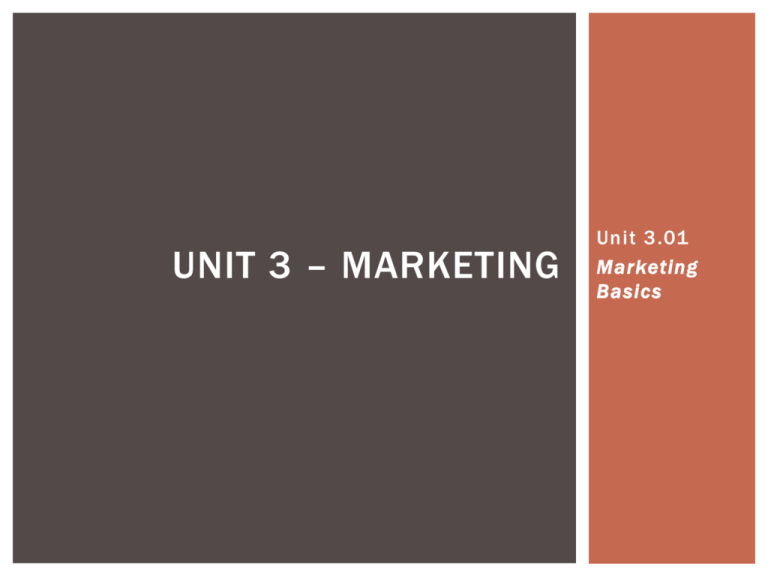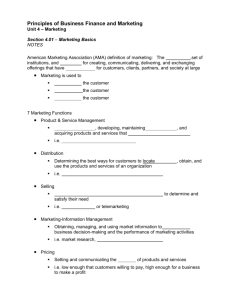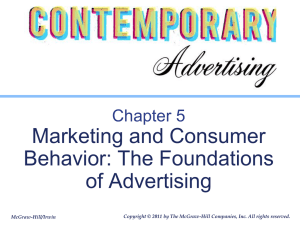Marketing Orientation
advertisement

UNIT 3 – MARKETING Unit 3.01 Marketing Basics KEY TERMS Marketing Final Consumers Marketing Strategy Business Consumers Target Market Consumer DecisionMaking Process Marketing Mix Marketing Orientation Buying Motives MARKETING The activity, set of institutions, and process for creating, communicating, delivering, and exchanging offerings that have value for customers, clients, partners, and society at large American Marketing Association Marketing is used to Identify the customer Satisfy the customer Keep the customer MARKETING FUNCTIONS MARKETING FUNCTIONS Product & Service Management Designing, developing, maintaining, improving, and acquiring products and services that meet consumer needs i.e. creating new products Distribution Determining the best ways for customers to locate, obtain, and use the products and services of an organization i.e. shipping, handling, and storing of products MARKETING FUNCTIONS Selling Communicating directly with potential customers to determine and satisfy their needs i.e. face to face or telemarketing Marketing-Information Management Obtaining, managing, and using market information to improve business decision-making and the performance of marketing activities i.e. market research, database management Pricing Setting and communicating the value of products and services i.e. low enough that customers willing to pay, high enough for a business to make a profit MARKETING FUNCTIONS Financial Analysis Budgeting for marketing activities, obtaining the necessary funds needed for operations, and providing financial assistance to customers so they can purchase the business’ products and services i.e. credit card payment systems Visa MARKETING FUNCTION Promotion Communicating information about products and services to potential customers i.e. advertising Most visible form of marketing Worldwide, over $545.4 Billion spent on advertising Television (commercials) Print (magazine ads) Radio Digital Media MARKETING FUNCTION Promotion In 2014, US spent $180 Billion on advertising Equates to $565 per person Biggest US spenders in 2014: Proctor & Gamble AT&T General Motors Comcast Verizon $4.6 $3.3 $3.1 $3.0 $2.5 Billion Billion Billion Billion Billion SLID E 10 MARKETING FUNCTION Promotion Procter & Gamble Tide detergent, Crest toothpaste, Cover Girl make up, etc. Why advertise so much? Consumer products Highly competitive Largest expenses? 1. 2. TV advertising Magazine advertising Expensive celebrity endorsements Easily reach target market MARKETING FUNCTION Promotion Amount spent on advertising varies MARKETING FUNCTION A Dealer for the People $18,000 monthly advertising budget MARKETING FUNCTION Promotion The most expensive commercials of all time CARLTON DRAUGHT: $1.5 million (2005) FERRARI/SHELL: $4.5 million (2007) HONDA: $6.2 million (2003) PEPSI: $8.1 million (2002) CHRYSLER: $12 million (2011) AVIVA: $13.4 million (2008) GUINNESS: $16 million (2007) CHANEL: $33 million (2004) MARKETING STRATEGY A company’s plan that identifies how it will use marketing to achieve its goals Need to come up with a good one ~ Marketing activities often cost 50% or more of the selling price of a product or service Advertising-to-Sales Ratio (A/S Ratio) Measurement of the effectiveness of an advertising campaign Calculated by dividing total advertising expenses by sales revenue High A/S Ratio – high advertising expenses resulted in low sales revenue Low A/S Ratio – the advertising campaign generated sales TARGET MARKET A specific group of consumers who have similar wants and needs Four ways to identify target markets 1. 2. 3. 4. Geographics: The location, size of the area, density, and climate zone of your customers. Demographics: The age, gender, income, family composition and size, occupation, and education of your customers. Psychographics: The general personality, behavior, life -style, rate of use, repetition of need, benefits sought, and loyalty characteristics of your customers. Behaviors: The needs they seek to fulfill, the level of knowledge, information sources, attitude, use or response to a product of your customers. TARGET MARKET Why target specific groups? Streamline advertising Focus on income level Understand buying behaviors Where would you find these advertisements? MARKETING MIX The blending of four marketing elements – product, placement (distribution), price, and promotion Known as the 4Ps Marketing Orientation – considers the needs of customers when developing a marketing mix UNDERSTAND CUSTOMERS If a product appeals to a group of customers with unsatisfied needs, it has a real chance to succeed If customers do not see a need or believe they have other choices that are better or less costly, the product will most likely not succeed 10 Famous Product Failures Sony Betamax (VCR cheaper) Coca Cola – New Coke (nothing wrong with old Coke) McDonald’s Arch Deluxe Burger (McD’s = fine dining) DeLorean DMC 12 (founder arrested for drug trafficking) UNDERSTANDING CUSTOMERS 2 Types of Customers Final Consumers AKA Business-to-Consumers (B2C) Persons who buy products and services mostly for their own use Can be done in-store or on-line E-Commerce Commercial transactions conducted electronically on the internet Played a large role in the rapid development of the commercial Internet in the 1990s Sold almost $1.5 Trillion in ecommerce worldwide in 2014 UNDERSTANDING CUSTOMERS 2 Types of Customers Business Consumers AKA Business-to-Business (B2B) When one business makes a commercial transaction with another Sourcing – a business purchases materials from another business that are needed to make their own product Example: a food manufacturer purchasing ingredients (salt, flour, sugar, etc.) Services – a business needs the services of another company to conduct their own business Example – hiring an accounting firm to audit their finances Resale – a business purchases goods or services with the intention of selling them rather than consuming or using them directly Example – a retail store stocking their shelves with products to sell consumers CONSUMER DECISION MAKING The specific sequence of steps consumers follow to make a purchase 1. Recognize a need 2. Gather information 3. Select and evaluate alternatives 4. Make a purchase decision 5. Determine the ef fectiveness of the decision BUYING MOTIVES Reasons consumers decide what products and ser vices to purchase Emotional Buying Motives When a buyer decides to purchase a product without thinking over the matter logically and carefully Without much reasoning Rational Buying Motives When a buyer decides to buy a certain thing after careful consideration After thinking over the matter consciously and logically BUYING MOTIVES Emotional Buying Motives Pride or Prestige Most common and strongest emotional buying motive Consumers feel that the possession of the product increases their social prestige or status Emulation or Imitation The desire to imitate other Why celebrity endorsements work so well Affection Goods are purchased out of love for others Want to do something nice for a loved one Comfort or desire for comfort Not a need, but a want that brings comfort Air conditioning, washing machine, cushion beds, etc. BUYING MOTIVES Emotional Buying Motives Sex Appeal Buyers purchase goods that will make them attractive to others Cosmetics, nice clothes, etc. Ambition Sales decisions based on a goal Drive a BMW by the time you’re 30, own a 3000 sq foot house Distinctiveness or Individuality People motivated to buy things that make them different from everyone else Recreation or Pleasure Vacation, boat, new car Hunger and Thirst Display signs or free samples at store Freshly baked cookie smell BUYING MOTIVES Rational Buying Motives Safety or Security Alarm systems on the home, safes, medicine, etc. Economy/Lower Price Purchase less expensive items to save money Couponing, generic brands, fuel efficient cars Suitability/Utility/Versatility Multiple use items Durability Long lasting/high quality items Convenience Purchase items that are easier, more convenient to use Automatic vs. manual car







